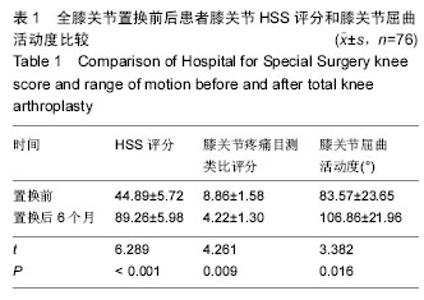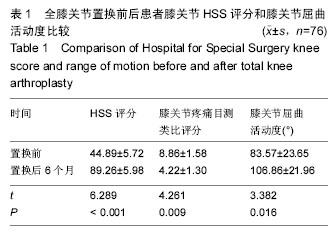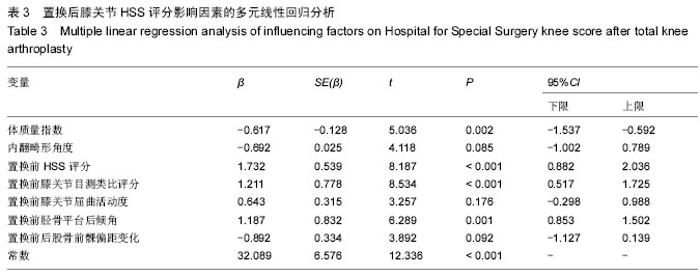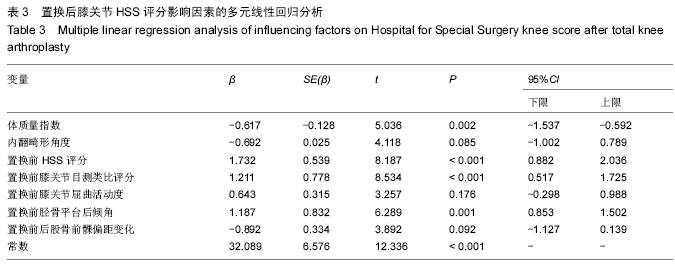Chinese Journal of Tissue Engineering Research ›› 2016, Vol. 20 ›› Issue (31): 4582-4588.doi: 10.3969/j.issn.2095-4344.2016.31.003
Previous Articles Next Articles
Influencing factors of knee function in osteoarthritis patients after total knee arthroplasty
Gao Ji-hai, Wang Jiang-quan, Lv Dong-wei
- Department of Joint Surgery, Dongying People’s Hospital, Dongying 257000, Shandong Province, China
-
Revised:2016-05-25Online:2016-07-22Published:2016-07-22 -
Contact:Yan Shu-yi, Chief physician, Department of Joint Surgery, Dongying People’s Hospital, Dongying 257000, Shandong Province, China -
About author:Gao Ji-hai, Associate chief physician, Department of Joint Surgery, Dongying People’s Hospital, Dongying 257000, Shandong Province, China
CLC Number:
Cite this article
Gao Ji-hai, Wang Jiang-quan, Lv Dong-wei . Influencing factors of knee function in osteoarthritis patients after total knee arthroplasty[J]. Chinese Journal of Tissue Engineering Research, 2016, 20(31): 4582-4588.
share this article
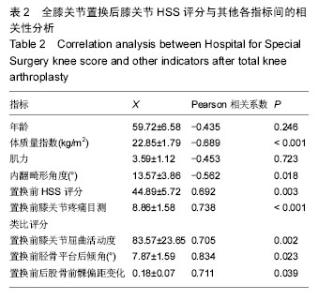
2.3 置换后膝关节HSS评分与各指标间的单因素分析 经Pearson相关分析,结果显示,置换前HSS评分、置换前膝关节疼痛目测类比评分、置换前膝关节屈曲活动度、置换前胫骨平台后倾角以及置换前后股骨前髁偏距变化与置换后膝关节HSS评分呈正相关关系, 体质量指数、内翻畸形角度与置换后膝关节HSS评分呈负相关关系(P < 0.05),与年龄、肌力无关(P > 0.05),见表2。 2.4 置换后膝关节HSS评分影响因素的多元线性回归分析 以患者置换后HSS评分为因变量,表2中有显著性意义的变量为自变量进行逐步筛选法的多重线性回归分析(α入=0.10,α出=0.15)。结果显示,体质量指数与置换后膝关节HSS评分呈负相关关系,置换前HSS评分、置换前膝关节疼痛目测类比评分及置换前胫骨平台后倾角与置换后HSS评分呈正相关关系(P < 0.05),而内翻畸形角度、置换前膝关节屈曲活动度、置换前后股骨前髁偏距变化与置换后HSS评分无关(P > 0.05),见表3。 2.5 不良事件 所有患者置换手术均顺利进行,术后恢复良好,无不良事件发生。"
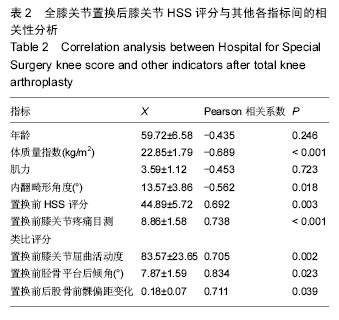
| [1] Bennell KL,Hall M,Hinman RS.Osteoarthritis year in review 2015: rehabilitation and outcomes. Osteoarthritis Cartilage. 2016;24(1):58-70. [2] Ji JB,Li XF,Liu L,et al.Effect of low intensity pulsed ultrasound on expression of TIMP-2 in serum and expression of mmp-13 in articular cartilage of rabbits with knee osteoarthritis.Asian Pac J Trop Med. 2015; 8(12):1043-1048. [3] Seo JG,Moon YW,Cho BC,et al.Is Total Knee Arthroplasty a Viable Treatment Option in Octogenarians with AdvancedOsteoarthritis.Knee Surg Relat Res. 2015;27(4):221-227. [4] 新苏雅拉图,张虎雄,刘峰,等.老年骨关节炎患者全膝关节置换术后关节功能的影响因素[J].中国老年学杂志,2013, 33(12):2915-2916. [5] Haase E,Lange T,Lutzner J,et al.Indication for total knee arthroplasty: evidence mapping.Z Evid Fortbild Qual Gesundhwes. 2015;109(8):605-614. [6] Bae KC,Cho CH,Lee KJ,et al.Efficacy of intra-articular injection of thrombin-based hemostatic agent in the control of bleeding after primary total knee arthroplasty.Knee Surg Relat Res. 2014;26(4):236-240. [7] Zanasi S.Innovations in total knee replacement: new trends in operative treatment and changes in peri-operative management.Eur Orthop Traumatol. 2011;2(1-2):21-31. [8] Shen HL,Li Z,Feng ML,et al.Analysis on hidden blood loss of total knee arthroplasty in treating knee osteoarthritis.Chin Med J (Engl). 2011;124(11): 1653-1656. [9] 周凯,罗雪梅,张焱,等.全膝表明置换术117例患者性别差异及原因分析[J].现代临床医学,2015,41(4): 284-285. [10] Dy CJ,Lyman S,Boutin-Foster C,et al.Do patient race and sex change surgeon recommendations for TKA.Clin Orthop Relat Res. 2015;473(2):410-417. [11] 张生海,付立明,马兆吉,等.全膝关节置换前后老年骨关节炎患者关节功能评估及影响因素[J].中国组织工程研究,2015,19(4):499-503. [12] 白国玺,徐小会,段永宏,等.全膝关节置换术治疗晚期类风湿性关节炎的早期临床随访研究[J].现代生物医学进展,2014,14(35):6926-6930. [13] Craik JD,El Shafie SA,Singh VK,et al.Revision of unicompartmental knee arthroplasty versus primary total knee arthroplasty. J Arthroplasty. 2015;30(4): 592-594. [14] Mook WR,Petri M,Greenspoon JA,et al.The Comprehensive Arthroscopic Management Procedure for Treatment of Glenohumeral Osteoarthritis. Arthrosc Tech. 2015;4(5):e435-441. [15] Riis A,Rathleff MS,Jensen MB,et al.Low grading of the severity of knee osteoarthritis pre-operatively is associated with a lower functional level after total knee replacement: a prospective cohort study with 12 months' follow-up. Bone Joint J. 2014;96-B(11): 1498-1502. [16] Zhang Q,Guo W,Liu Z,et al.Minimally invasive unicompartmental knee arthroplasty in treatment of osteonecrosis versusosteoarthritis: a matched-pair comparison.Acta Orthop Belg. 2015;81(2):333-339. [17] Kuijer PP,Kievit AJ,Verbeek JH,et al.Knee joint replacement and individual susceptibility for progression of knee osteoarthritis and tibial cartilage volume loss: not only genes run in the family.Osteoarthritis Cartilage. 2015;23(10): 1817-1818. [18] 李玉安,谷长跃,王佳音,等.膝关节置换术及假体的研究进展[J].中国老年学杂志,2013,33(6):1462-1464. [19] 张启栋,郭万首,刘朝晖,等.内翻畸形膝骨关节炎软骨磨损的临床研究[J].中国矫形外科杂志,2013,21(23): 2345-2350. [20] Jevsevar D,Donnelly P,Brown GA,et al. Viscosupplementation for Osteoarthritis of the Knee: A Systematic Review of the Evidence.J Bone Joint Surg Am. 2015;97(24):2047-2060. [21] 沈彬,裴福兴.膝关节骨关节炎诊治进展[J].现代临床医学, 2013,39(5):390-394. [22] 叶一林,柴卫兵,卢宏章,等.伴有关节外畸形的膝骨关节炎行全膝关节置换术的治疗体会[J].中国骨与关节外科, 2014,7(5):399-403. [23] Parratte S,Ollivier M,Opsomer G,et al.Is knee function better with contemporary modular bicompartmental arthroplasty compared tototal knee arthroplasty? Short-term outcomes of a prospective matched study including 68 cases.Orthop Traumatol Surg Res. 2015;101(5):547-552. [24] Kim YH,Park JW,Kim JS,et al.Long-Term Clinical Outcomes and Survivorship of Revision Total Knee Arthroplasty with Use of a Constrained Condylar Knee Prosthesis.J Arthroplasty. 2015;30(10): 1804-1809. [25] Arirachakaran A,Choowit P,Putananon C,et al.Is unicompartmental knee arthroplasty (UKA) superior to total knee arthroplasty (TKA)? A systematic review and meta-analysis of randomized controlled trial. Eur J Orthop Surg Traumatol. 2015;25(5):799-806. [26] 司枫.老年膝关节骨关节炎应用全膝关节置换术疗效观察[J].包头医学院学报,2013,29(5):47-49. [27] 胡三莲,丁佳凤,许鑫,等.全膝关节置换术后患者居家康复锻炼效果的影响因素分析[J].护士进修杂志,2012, 27(10): 919-921. [28] 张冠英.全膝置换术治疗老年骨关节炎(OA)的疗效及其影响因素[J].中外医疗,2013,32(10):61-62. [29] Nagai K,Muratsu H,Matsumoto T,et al.Influence of intra-operative parameters on postoperative early recovery of active knee flexion in posterior-stabilized total knee arthroplasty.Int Orthop. 2013;37(11): 2153-2157. [30] Kerkhoffs GM,Servien E,Dunn W,et al.The influence of obesity on the complication rate and outcome of total knee arthroplasty: a meta-analysis and systematic literature review.J Bone Joint Surg Am. 2012;94(20): 1839-1844. [31] Lee SY,Bae JH,Kim JG,et al.The influence of surgical factors on dislocation of the meniscal bearing after Oxford medial unicompartmental knee replacement: a case-control study.Bone Joint J. 2014;96-B(7): 914-922. [32] Chang CB,Kim TK,Kang YG,et al.Prevalence of osteoporosis in female patients with advanced knee osteoarthritis undergoing total knee arthroplasty.J Korean Med Sci. 2014;29(10):1425-1431. [33] Nemes S,Rolfson O,W-Dahl A,et al.Historical view and future demand for knee arthroplasty in Sweden.Acta Orthop. 2015;86(4):426-431. [34] Burnett RS, Barrack RL.Computer-assisted total knee arthroplasty is currently of no proven clinical benefit: a systematic review. Clin Orthop Relat Res. 2013;471(1): 264-276. [35] Huang Z,Ma J,Shen B,et al.General anesthesia: to catheterize or not? A prospective randomized controlled study of patients undergoing total knee arthroplasty. J Arthroplasty. 2015;30(3):502-506. [36] 侯来永,王廉,谢欲晓,等.全膝关节置换术后个性化系统康复的疗效观察[J].中国康复医学杂志,2008,23(8): 707-710. [37] Oberbek J,Synder M.Impact of Body Mass Index (BMI) on Early Outcomes of Total Knee Arthroplasty. Ortop Traumatol Rehabil. 2015;17(2):127-134. [38] Mackie A,Muthumayandi K,Shirley M,et al.Association between body mass index change and outcome in the first year after total knee arthroplasty.J Arthroplasty. 2015;30(2):206-209. [39] Dusad A,Pedro S,Mikuls TR,et al.Impact of Total Knee Arthroplasty as Assessed Using Patient-Reported Pain and Health-Related Quality of Life Indices: Rheumatoid Arthritis Versus Osteoarthritis.Arthritis Rheumatol. 2015;67(9):2503-2511. [40] Bae DK,Song SJ,Yoon KH,et al.Comparative study of tibial posterior slope angle following cruciate-retaining total knee arthroplasty using one of three implants. Int Orthop. 2012;36(4):755-760. |
| [1] | Liang Xin, Wang Heng, Li Xian-rong. Preoperative application of alprazolam for patients with anxiety and depression and pain after total knee arthroplasty: its safety and effectiveness [J]. Chinese Journal of Tissue Engineering Research, 2017, 21(7): 985-992. |
| [2] | Shi Bin, An Jing, Chen Long-gang, Zhang Nan, Tian Ye . Influencing factors for pain after total knee arthroplasty [J]. Chinese Journal of Tissue Engineering Research, 2017, 21(7): 993-997. |
| [3] | Wang Xian-xun. Impact of local compression cryotherapy combined with continuous passive motion on the early functional recovery after total knee arthroplasty [J]. Chinese Journal of Tissue Engineering Research, 2017, 21(7): 998-1003. |
| [4] | Lu Yao-jia, Xiong Chuan-zhi, Li Xiao-lei, Hu Han-sheng, Chen Gang, Wang Qiang, Lu Zhi-hua. Comparison of two methods for reducing blood loss during total knee arthroplasty [J]. Chinese Journal of Tissue Engineering Research, 2017, 21(7): 1004-1008. |
| [5] | Yuan Wei, Zhao Hui, Ding Zhe-ru, Wu Yu-li, Wu Hai-shan, Qian Qi-rong. Association between psychological resilience and acute mental disorders after total knee arthroplasty [J]. Chinese Journal of Tissue Engineering Research, 2017, 21(7): 1015-1019. |
| [6] | Chen Qun-qun, Qiao Rong-qin, Duan Rui-qi, Hu Nian-hong, Li Zhao, Shao Min. Acu-Loc®2 volar distal radius bone plate system for repairing type C fracture of distal radius [J]. Chinese Journal of Tissue Engineering Research, 2017, 21(7): 1025-1030. |
| [7] | Huang Xiang-wang, Liu Hong-zhe. A new low elastic modulus of beta titanium alloy Ti2448 spinal pedicle screw fixation affects thoracic stability: biomechanical analysis [J]. Chinese Journal of Tissue Engineering Research, 2017, 21(7): 1031-1035. |
| [8] | Xie Qiang. Three-dimensional finite element model for biomechanical analysis of stress in knee inversion and external rotation after posterior cruciate ligament rupture [J]. Chinese Journal of Tissue Engineering Research, 2017, 21(7): 1036-1040. |
| [9] | He Ze-dong, Zhao Jing, Chen Liang-yu, Li Ke, Weng Jie. Multilevel finite element analysis on the biological tribology damage of water on bone tissue [J]. Chinese Journal of Tissue Engineering Research, 2017, 21(7): 1041-1045. |
| [10] | Jiang Zi-wei, Huang Feng, Cheng Si-yuan, Zheng Xiao-hui, Sun Shi-dong, Zhao Jing-tao, Cong Hai-chen,Sun Han-qiao, Dong Hang. Design and finite element analysis of digital splint [J]. Chinese Journal of Tissue Engineering Research, 2017, 21(7): 1052-1056. |
| [11] | Wang Fei, Liu Zhi-bin, Tao Hui-ren, Zhang Jian-hua, Li Chang-hong, Cao Qiang, Zheng Jun, Liu Yan-xiong, Qu Xiao-peng. Clinical efficacy of preoperative osteotomy designs using paper-cut technology versus photoshop software for ankylosing spondylitis with kyphosis [J]. Chinese Journal of Tissue Engineering Research, 2017, 21(7): 1057-1063. |
| [12] | Li Hui, Ma Jun-yi, Ma Yuan, Zhu Xu . Establishment of a three-dimensional finite element model of ankylosing spondylitis kyphosis [J]. Chinese Journal of Tissue Engineering Research, 2017, 21(7): 1069-1073. |
| [13] | Ling Guan-han, Ou Zhi-xue, Yao Lan, Wen Li-chun, Wang Guo-xiang, Lin Heng-feng. Establishment of simulating three-dimensional model of China-Japan Friendship Hospital Classification for L type osteonecrosis of the femoral head [J]. Chinese Journal of Tissue Engineering Research, 2017, 21(7): 1074-1079. |
| [14] | Fu Wei-min, Wang Ben-jie. Assessing the degree of necrotic femoral head, and association of blood supply with pathlogical changes: study protocol for a diagnostic animal trial [J]. Chinese Journal of Tissue Engineering Research, 2017, 21(7): 1086-1091. |
| [15] | Zhang Wen-qiang, Ding Qian, Zhang Na. Associations between alpha angle and herniation pit on oblique axial magnetic resonance imaging in asymptomatic hip joints of adults [J]. Chinese Journal of Tissue Engineering Research, 2017, 21(7): 1098-1103. |
| Viewed | ||||||
|
Full text |
|
|||||
|
Abstract |
|
|||||
